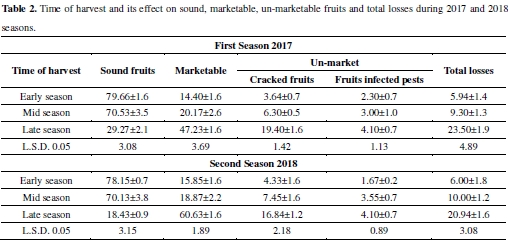Estimation of post-harvest losses of Manfalouty pomegranate fruits
Abstract
Weight loss considered one of the main causes of quality loss in pomegranate fruits during chain marketing. Therefore, this study was conducted on Manfalouty pomegranate (Punica granatum L.) in a private orchard in El Badary, Assiut Governorate, Egypt in 2017 and 2018 to define the various causes of losses during chain handing and estimate it. The fruits harvested at three periods early (September) mid (October) and late season (November). The total losses at harvest were 5.94%, 9.30% and 23.50% for early, mid and late season, respectively. The main cause of losses is due to cracked and infected pests. The total loss of fruits during chain marketing was highest in retail market in comparison with wholesale during early, mid and late season. The main causes of losses due to weight loss and shrinkage fruits. According to data dealing with storage pomegranate fruits at 5±1°C and relative humidity 85-90%, the highest fruit losses found in the third month and this losses due to fruit weight loss and internal chilling injury (brown discoloration) so the storage life of fruit should be two months.
Downloads
References
2. Sreenivasa Murthy SD, Gajanana TM, Sudha M, Dakshinamoorthy V. Marketing and post-harvest losses in fruits: its implications on availability and economy. Ind J Agric Econ. 2009; 64(2): 259-275.
3. El Oraby S, Meshrakeand Amal A, Hassan M. Attempts to improve postharvest handling of pomegranate fruits to extend storage as shipping periods. Egypt J Appl Sci. 2009; 24(3B): 700-715.
4. Mahajan PV, Oliviera FAR, Macedo I. Effect of temperature and relative humidity on the transpiration rate of the whole mushrooms. J Food Engin. 2008; 84: 281-288.
5. Caleb O, Mahajan PV, Al Said FA, Opara UL. Transpiration rate and quality of pomegranate arils as affected by storage conditions. CYTA J Food. 2013; 11(3): 199-207.
6. Yahaya SM, Mardiyya, AY. Review of postharvest losses of fruits and vegetables. Biomed J Sci Tech. 2019; 13(4): 10192-10200.
7. AOAC. Official method analysis. Association of Official Analytical Chemists, Washington, DC., USA, 1985.
8. Ranganna, S. Manual of Analysis of fruit and vegetable products. Tata Mc Graw Hill Publishing company Ltd, New Delhi, 1979; 12: 87-88.
9. Snedeco GW, Cochran WG. Statistical methods, 7th edn, Iowa State University Press, Ames, IA, USA, 1990.
10. Fawole OA, Opara UL. Effect of storage temperature and duration on physiological response of pomegranate fruit. Indust Crops Prod. 2013; 47: 300-309.
11. Arends E, Fawole OA, Opara UL. Influence of storage temperature and duration on postharvest physico-chemical and mechanical properties of pomegranate fruit arils. CYTA J Food. 2014; 12: 389-398.
12. Kader AA, Barret DM. Classification, composition of fruits and postharvest maintenance of quality. In: Processing fruits, science and technology. 2nd edn. Boca Raton, Florida, USA: CRC press, 2005: 3-22.
13. Mshraky AM, Nagy K, Fekry OM. Effect of modified atmosphere and smart packaging on the quality and storability of “wonderful” pomegranate cv. Middle East J Appl Sci. 2017; 7(1): 92-101.
14. Abd El Maaboud AS, El Oraby SM, Hassan AM. Effect of cold treatment as a postharvest treatment for killing immature stage of the peach fruit fly Bactrocera zonata, and its effect on fruit quality of pomegranate. J Plant Prot Path Mansoura Univ. 2018; 9(12): 843-847.
15. Miguel G, Catarina F, Dulce A, Alcinda N, Denise M. Anthocyanin concentration of Assaria pomegranate. J Biomed Biotechnol. 2004; 2004(5): 338-342.
16. Karav S, Ardic OA, Eksi A. Effect of cold storage of various pomegranate cultivars fruit juices on health promoting compounds and their activities. Food Nutr Res. 2015; 3(90): 593-598.


This work is licensed under a Creative Commons Attribution 4.0 International License.




